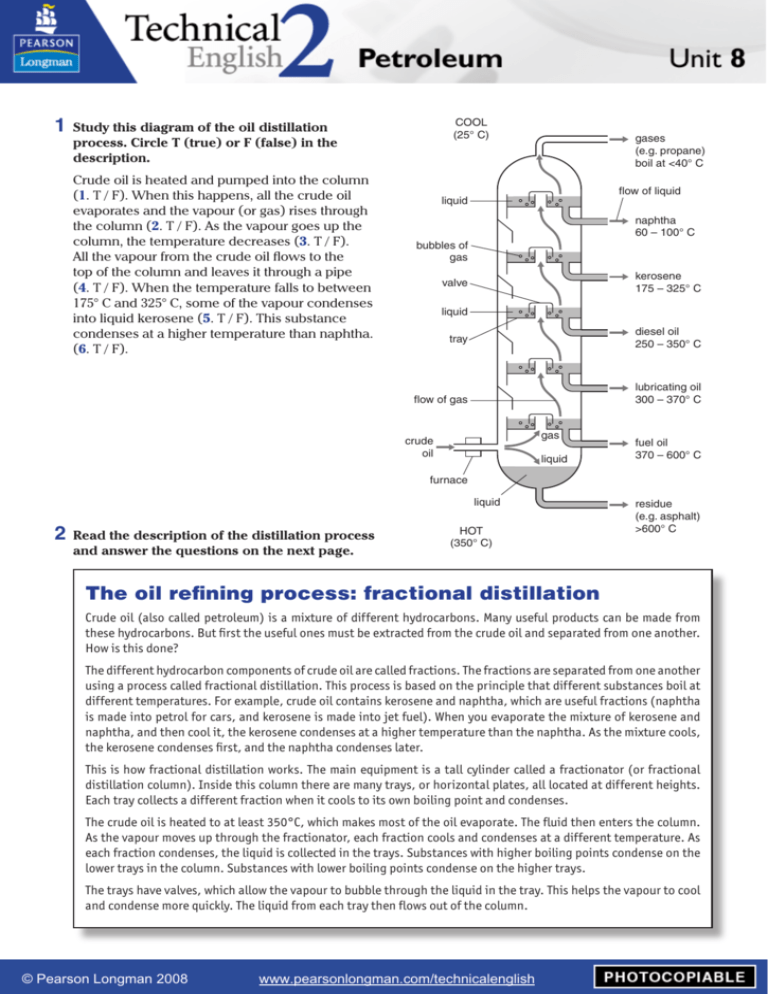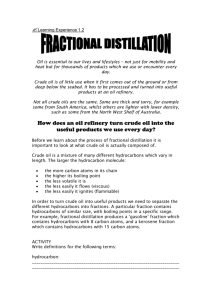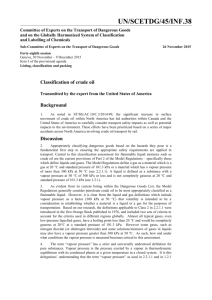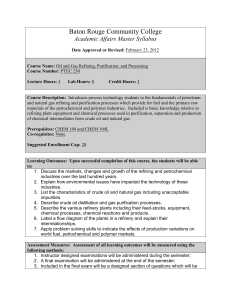
1 Study this diagram of the oil distillation
COOL
(25° C)
process. Circle T (true) or F (false) in the
description.
Crude oil is heated and pumped into the column
(1. T / F). When this happens, all the crude oil
evaporates and the vapour (or gas) rises through
the column (2. T / F). As the vapour goes up the
column, the temperature decreases (3. T / F).
All the vapour from the crude oil flows to the
top of the column and leaves it through a pipe
(4. T / F). When the temperature falls to between
175° C and 325° C, some of the vapour condenses
into liquid kerosene (5. T / F). This substance
condenses at a higher temperature than naphtha.
(6. T / F).
gases
(e.g. propane)
boil at <40° C
flow of liquid
liquid
naphtha
60 – 100° C
bubbles of
gas
kerosene
175 – 325° C
valve
liquid
tray
diesel oil
250 – 350° C
flow of gas
lubricating oil
300 – 370° C
gas
crude
oil
liquid
fuel oil
370 – 600° C
furnace
liquid
2 Read the description of the distillation process
and answer the questions on the next page.
residue
(e.g. asphalt)
>600° C
HOT
(350° C)
The oil refining process: fractional distillation
J7188
PEARSON Technical English
products can beaw_08_01.eps
made from
Crude oil (also called petroleum) is a mixture of different hydrocarbons. Many useful
these hydrocarbons. But first the useful ones must be extracted from the crude oil and separated from one another.
How is this done?
The different hydrocarbon components of crude oil are called fractions. The fractions are separated from one another
using a process called fractional distillation. This process is based on the principle that different substances boil at
different temperatures. For example, crude oil contains kerosene and naphtha, which are useful fractions (naphtha
is made into petrol for cars, and kerosene is made into jet fuel). When you evaporate the mixture of kerosene and
naphtha, and then cool it, the kerosene condenses at a higher temperature than the naphtha. As the mixture cools,
the kerosene condenses first, and the naphtha condenses later.
This is how fractional distillation works. The main equipment is a tall cylinder called a fractionator (or fractional
distillation column). Inside this column there are many trays, or horizontal plates, all located at different heights.
Each tray collects a different fraction when it cools to its own boiling point and condenses.
The crude oil is heated to at least 350°C, which makes most of the oil evaporate. The fluid then enters the column.
As the vapour moves up through the fractionator, each fraction cools and condenses at a different temperature. As
each fraction condenses, the liquid is collected in the trays. Substances with higher boiling points condense on the
lower trays in the column. Substances with lower boiling points condense on the higher trays.
The trays have valves, which allow the vapour to bubble through the liquid in the tray. This helps the vapour to cool
and condense more quickly. The liquid from each tray then flows out of the column.
© Pearson Longman 2008
www.pearsonlongman.com/technicalenglish
Answer these questions on the reading text in your exercise book:
1 Why do different substances need to be extracted from crude oil?
2 What fact of science does fractional distillation use?
3 Which component of the column collects the condensed liquid from each fraction?
4 What is the function of the valves on each tray?
3 Put these stages in the distillation process into the correct order. Write a number (1 – 8) next to
each stage.
A
As the vapour rises through the trays in the column, the temperature falls.
B
The condensed liquid of the fraction is collected in a tray.
C
When a fraction in the vapour cools to its own boiling point, it condenses.
D
1 This is how the distillation process in the fractionator works.
E
Most of the fractions in the crude oil evaporate.
F
The condensed liquid flows out of the fractionator through a pipe from the tray.
G
High-pressure steam is used to heat the crude oil to a high temperature.
H
The crude oil vapour enters the fractionator and rises up the column.
4 Complete these sentences using each word from the box once only. Use capital letters where necessary.
for, as, that, to, by, which, when, from
1 Jet fuel is made from kerosene,
2
naphtha vapour is cooled to between 60 and 100° C, it condenses.
3 Diesel oil is produced
4
condenses between 175° C and 325° C.
cooling crude oil vapour to between 250 and 300° C.
crude oil vapour rises through the fractionator, it cools.
5 Lubricating oil is used
reducing friction between moving parts.
6 The boiling point of industrial fuel oil ranges
7 A fractionator is a tall column
8 The trays in the column are designed
370° C to 600° C.
is filled with trays or plates at several levels.
allow contact between vapour and liquid.
5 Rewrite these sentences using the passive form of the verbs.
1 You have to refine crude oil so that you can use it for petrol or jet fuel.
Crude oil
so that it
fuel.
2 In the past, people burnt crude oil in lamps, but now they extract kerosene from it.
In the past, crude
, but now kerosene
3 When you boil crude oil, you convert most of the fractions into vapour.
When crude oil
, most of
4 The trays collect the condensed fluid and then a pipe carries it out of the fractionator.
The condensed
trays, and then it
© Pearson Longman 2008
www.pearsonlongman.com/technicalenglish
it.
vapour.
pipe.
Word list
6 Write the meanings of these words and phrases in your own language.
NOUNS
NOUN PHRASES
asphalt
boiling point
column
crude oil
fraction
diesel oil
fractionator
fractional distillation
furnace
fractional distillation column
hydrocarbon
kerosene
fuel oil
naphtha
high-pressure steam
petroleum
industrial fuel oil
propane
jet fuel
residue
lubricating oil
substance
oil refining
tray
VERBS
bubble
collect
extract
separate
© Pearson Longman 2008
www.pearsonlongman.com/technicalenglish







